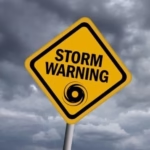Let’s face it, Ireland is no stranger to stormy weather. But when a big one like Storm Ivo rolls in, it’s always worth taking a moment to prepare and stay informed. If you’ve been hearing its name pop up on news alerts or your aunt’s Whatsapp group, don’t panic—we’ve got all the details you need to know.
From understanding Ivo’s impact to practical tips from Met Éireann, let’s break it all down in a way that’s easy to digest.
Understanding Storm Ivo
So, what exactly is Storm Ivo? Think of it as Mother Nature flexing her muscles (again). Storm Ivo is the latest in the series of storms to hit Ireland, originating as an intense low-pressure system fueled by moisture-laden Atlantic air.
If you’re getting flashbacks to Storm Éowyn from last winter, you’re not alone. While Éowyn hit with heavier snow in the north, Ivo is bringing a messy cocktail of heavy rains, strong winds, and some flood risks. Unlike Éowyn, Ivo’s power lies in its gusty vengeance rather than sheer cold.
Current Status (as of today):
Here’s the low-down from Met Éireann:
- Severe Weather Warnings: Orange-level rainfall warnings are in effect for parts of Cork and Kerry. Expect 30-50mm of rain, with higher totals in mountainous areas.
- High Winds: Winds are reaching speeds of up to 110km/h along the south and southwest coast, with inland gusts also packing a punch.
- Flood Threat: Flood alerts are already in place as rivers are nearing their limits, especially in coastal areas. Keep an eye out for localized flooding in urban centers like Galway and Limerick.
Weather Impacts in Ireland
Rainfall: A Stormy Soak
Heavy rainfall will be hitting hardest in the southwest and midlands. The table below gives a clear breakdown of predicted rainfall levels in affected areas:
| Region | Rainfall (mm) | Flood Risk |
|---|---|---|
| Cork & Kerry | 50-70 | High |
| Munster Midlands | 30-50 | Medium |
| Southeast Counties | 20-40 | Low to Medium |
If you live in these areas, don’t be surprised if you find roads temporarily impassable or your favorite riverside café looking a little too riverside.
Strong Wind Gusts: Hold onto Your Hat!
Winds are expected to lash the southern coastline, so we’re talking uprooted trees, travel delays, and maybe a few flying garden chairs. Counties along the coast like Cork, Wexford, and Waterford will feel the worst of it. According to BBC Weather, inland areas won’t escape unscathed either, with gusts strong enough to make cycling home an extreme sport.
Coastal Conditions: High Waves and Erosion Risks
Beaches may look dramatic, but Met Éireann has advised everyone—yes, surfers too—to stay away from the coastline during the storm. Waves as high as 5-7 meters could lead to coastal flooding and erosion in exposed areas.
Safety Tips from Met Éireann
When a storm comes knocking, a little preparation goes a long way. Here are some quick and practical tips:
Prepare Your Home
- Secure outdoor furniture, trampolines, or anything else that could become airborne.
- Have essential items on hand: flashlights, batteries, non-perishable food, water, and a first-aid kit.
- Unblock your gutters and keep drainage grates clear to reduce flood risks.
Travel Smart
- Avoid unnecessary road trips, especially in areas under weather warnings.
- If you must travel, AA Ireland advises reducing your speed and watching out for surface water and fallen debris.
- Cyclists and pedestrians? Stay visible, avoid exposed routes, and consider putting the trusty bike in the shed until the worst is over.
During the Storm
- If power cuts hit, make sure you’re prepped with candles or portable chargers for your phone (essential for scrolling TikTok while waiting it out).
- Stay indoors and avoid walking near fallen trees, power lines, or flooded areas.
Regional Impacts
Different parts of the island are experiencing Ivo’s wrath differently.
South and Southwest Ireland
Counties like Cork, Kerry, and Waterford are facing the brunt of the storm with a mix of soaking rains, howling winds, and significant flood concerns. For Cork residents, this might bring flashbacks to past storms like Barra or Lorenzo. Quick tip: If you’ve been procrastinating on sandbagging that back door—now’s the time.
Northern & Higher Altitude Areas
In contrast, Counties up north might see lighter rains but look out for potential hail or snow showers as temperatures drop once the storm clears. Heads up, winter-monks—these conditions may present opportunities for snowboarding but always assess avalanche and snow depth risks before heading into the hills.
What Happens After Ivo?
While Ivo is expected to weaken heading into early next week, the aftermath could still leave behind localized flooding and fallen debris.
Recovery Plans:
- Check your property for damage safely (those roof tiles can wait).
- If your area has been hit especially hard, reach out to local councils or Citizen’s Information to report issues or find resources.
- On a community note, pop in to check on elderly neighbors or offer to help anyone who needs assistance managing storm impacts. Sharing an extra loaf of bread can go a long way!
Wrapping Up
Let’s keep it simple: Storm Ivo is no small storm. With heavy rains, strong winds, and potential damage, it’s better to stay cautious. Take those safety tips from Met Éireann seriously, prep your home, and avoid unnecessary travel.
Of course, while we weather the literal storm, let’s not forget the power of community. Whether it’s helping a neighbor secure their shed or sharing reliable weather updates, we’re all in this together.
And hey, it’s Ireland—another storm will probably roll through next season. But now you’ve got the preparation tips down pat. Want to stay one step ahead of future storms? Bookmark Met Éireann’s website or follow them on social media for live updates.
Now let the kettle boil, stay cozy, and let Ivo pass. You earned it ☕.














